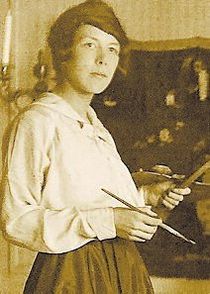Sigrid Hjerten
| Sigrid Hjertén | |
|---|---|

Sigrid Hjertén at work
|
|
| Born | 27 October 1885 Sundsvall, Sweden |
| Died | 24 March 1948 (aged 62) , Sweden |
| Nationality | Swedish |
| Known for | Painting |
| Movement | Modernism |
Sigrid Hjertén (27 October 1885–24 March 1948), was a Swedish modernist painter. Hjertén is considered a major figure in Swedish modernism. Periodically she was highly productive and participated in 106 exhibitions. She worked as an artist for 30 years before dying of complications from a botched lobotomy for schizophrenia.
Sigrid Hjertén was born in Sundsvall in 1885. She studied at the University College of Arts, Crafts and Design in and graduated as a drawing teacher. At a studio party in 1909, Hjertén met her future husband, twenty-year-old Isaac Grünewald, who had already studied one year with Henri Matisse in Paris. Grünewald convinced her that she would do herself more justice as a painter. Later that year she went to Matisse's art school as well.
As she studied under Henri Matisse in Paris, she was impressed by the way he and Paul Cézanne dealt with colour. This shows in her painting in contrasting colour fields and simplified contours, her way of achieving the greatest possible expressiveness. Her aesthetic intentions had primarily to do with colour, and in her later works from the 1930s she spoke of colours in terms such as cold yellow. Hjertén strove to find forms and colours that could convey her emotions. In that respect her work is more closely related to the German Expressionists, such as Ernst Ludwig Kirchner, than to the French painters, with their graceful play of lines.
After a year and a half she returned to Sweden. In 1912 Sigrid Hjertén participated in a group show in Stockholm. It was her debut exhibition as a painter. In the following ten years she took part in many exhibitions both in Sweden and abroad, among other places in Berlin in 1915, where she was well received. Sigrid Hjertén was also represented at the Expressionist Exhibition at the Liljevalch's konsthall in Stockholm in 1918, together with two other artists. However, the contemporary critics were not enthusiastic about her art.
...
Wikipedia
